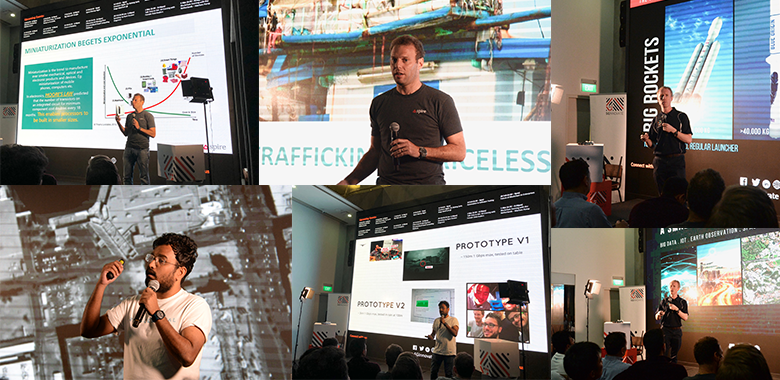So you want to be the next Elon Musk? Here are five things you should know

- Once dominated by large government space agencies, space tech is no longer a pipe dream for smaller players, said astropreneurs at SGInnovate’s Space Startup Night
- Miniaturisation and light, lean and adaptable business models are growing trends that have allowed startups to thrive in the ‘NewSpace’ economy
- In addition to space exploration, space tech also has many applications on Earth, giving startups many potential avenues for growth
If you’re a space buff who grew up in a small country like Singapore, you might long ago have shelved any space-related career ambitions, relegating yourself to watching from afar as Elon Musk and large national space agencies like NASA explore the cosmos.
But today, space is no longer the exclusive domain of big players with deep pockets. Advances in artificial intelligence, robotics and miniaturisation technology have made it much cheaper and easier for smaller countries, private sector players and even startups to get in on the space tech action.
That the era of ‘NewSpace’ or ‘Space 2.0’ is upon us was evident at SGInnovate’s Space Startup Night on 8 February 2018. During the discussion, leaders of three space tech companies with a Singapore presence shared their astropreneurship experiences with a packed audience.
Budding astropreneurs, listen up—here are five lessons TechNews took away from the session.
1. Think small
Small is the new big—just as computers have gone from room-sized mainframes to pocket-friendly mobile phones, satellites have also shrunk considerably over the past few decades. “Miniaturisation technology is allowing satellites to go from the size of a bus to the size of a toaster,” said Mr Adam Gilmour, founder and CEO of Gilmour Space Technologies, a rocket company based in Singapore and Australia.
Small satellites such as nanosatellites or CubeSats are now being used in a wide variety of applications, including asset tracking, data collection and telecommunications. Their small size comes with enormous advantages—they are much cheaper to produce and launch into space, and can be deployed in fleets of tens or hundreds.
Accordingly, rockets too can be scaled down. Gilmour Space Technologies specialises in building lower-cost, smaller rockets for taking lighter payloads into orbit, thus addressing the growing market for nanosatellite launches. “NewSpace doesn’t need a Falcon Heavy—it needs a small launcher like ours,” said Mr Gilmour.
2. Iterate, iterate, iterate
Perhaps more so than in other sectors, engineering flaws in space tech can cost companies dearly in both time and money. Extensive field-testing, both on the ground and in flight, is therefore critical to success. “We believe in testing more frequently, so when you fail, you fail early, before you blow a lot of money on an orbital rocket,” said Mr Gilmour.
The good news is that as space tech gets smaller and cheaper, astropreneurs can now start to treat hardware development more like software development, where multiple iterations based on customer feedback are the norm, said Mr Mark Dembitz, head of Asia Pacific Sales & Business Development at Spire, a satellite data analytics company with a Singapore office. “You can’t do that with traditional satellites unless you have billions and billions of dollars,” he explained.
3. Use the power of platforms
Spire uses its nanosatellite network to gather weather, maritime and aviation data, which it then analyses to generate insights for its customers. But the company also sees the network as a platform which customers can use for any number of custom space applications.
“As technology evolves, we can use this platform of satellites to do things that I can’t even dream of today, but maybe people in this room can,” said Mr Dembitz, challenging the audience to think about what technologies can be miniaturised for use on nanosatellites. “Create use cases, create payloads and come to us—we’ll put them on our satellites.”
4. Keep your feet on the ground
While astropreneurs may have lofty aspirations of colonising Mars, mining asteroids and travelling to distant stars, the reality is that technology for deep space exploration is going to take decades to build. Space tech companies thus need a viable business plan for staying afloat in the here and now.
Fortunately, space tech also has plenty of applications on the ground. Take Transcelestial Technologies, for instance—while working towards the goal of building a laser satellite communications network that will enable communication in deep space, the Singapore company is already using its technology to help telcos achieve 5G connectivity. “This is effectively a kickstart for us to go on to space and build this immensely complex technology,” said the company’s co-founder and CEO Mr Rohit Jha.
5. But don’t forget to dream big
That said, running a commercially viable business doesn’t mean forgoing the opportunity to dream big. Indeed, space tech and space exploration have enormous potential in the long run to make a real impact on the future of human civilisation.
On the Kardashev scale of technological advancement, humanity at present doesn’t even make the cut for a Type I civilisation, defined as one that can harness all the energy it receives from its closest star. In our case, to qualify as a Type I civilisation, we would need to be able to harvest all the sunlight that reaches us. Primitive as we may be at present, astropreneurs like Transcelestial’s Mr Jha are already aspiring to more.
“Becoming a Type II civilisation is not a bad goal to dream of,” he said. “What that means is we should be able to fully use the energy of our own sun [i.e. not just the sunlight that reaches us]. That will unlock the capability for interplanetary travel and allow us to grow in our own solar system.”
https://www.tech.gov.sg/media/technews/so-you-want-to-be-the-next-elon-musk-Here-are-five-things-you-should-know
